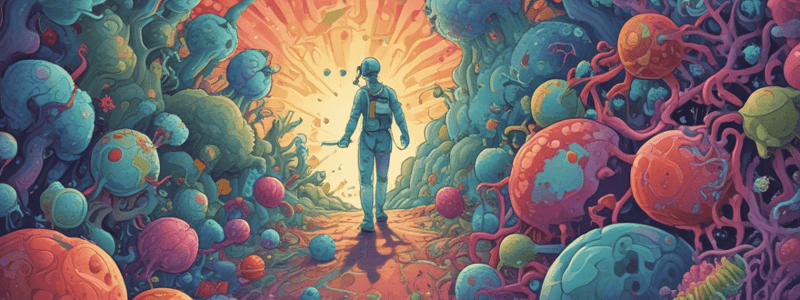Podcast
Questions and Answers
What is the primary difference between viruses and subviral particles?
What is the primary difference between viruses and subviral particles?
- Subviral particles have a lipid envelope while viruses do not
- Viruses can reproduce on their own while subviral particles cannot
- Subviral particles are smaller than viruses (correct)
- Viruses are living while subviral particles are nonliving
What are the two main types of subviral particles?
What are the two main types of subviral particles?
- Prions and chromosomes
- Viroids and lipids
- Proteins and RNA
- Viroids and prions (correct)
What is unique about the RNA of viroids?
What is unique about the RNA of viroids?
- It is made of DNA
- It is double-stranded
- It is always found in humans
- It is single-stranded and circular (correct)
Why are viroids thought to be catalytic?
Why are viroids thought to be catalytic?
What is a characteristic that viruses and subviral particles share?
What is a characteristic that viruses and subviral particles share?
Why do viruses and subviral particles need a host?
Why do viruses and subviral particles need a host?
What was a previous limitation in the discovery of viroids?
What was a previous limitation in the discovery of viroids?
What is a recent development in the discovery of viroids?
What is a recent development in the discovery of viroids?
What is the main difference between viroids and virions?
What is the main difference between viroids and virions?
What makes prions different from viruses and viroids?
What makes prions different from viruses and viroids?
What is the normal conformation of a protein?
What is the normal conformation of a protein?
What happens when a prion protein comes into contact with a normal protein?
What happens when a prion protein comes into contact with a normal protein?
What is the result of protein deposits forming in the brain?
What is the result of protein deposits forming in the brain?
What is the name of the protein that makes up a prion?
What is the name of the protein that makes up a prion?
What is thought to be the mechanism by which prions cause infection?
What is thought to be the mechanism by which prions cause infection?
Why are scientists still uncertain about prions?
Why are scientists still uncertain about prions?
Flashcards are hidden until you start studying
Study Notes
Subviral Particles
- Subviral particles are smaller than viruses and are categorized as nonliving infectious agents.
- Nonliving infectious agents include viruses and subviral particles, which are acellular, meaning they're only made of a protein coat, or a capsid, that protects genetic information (DNA or RNA).
Characteristics of Viruses
- Viruses require a host to make their own energy (ATP) and reproduce.
- They can't divide or reproduce on their own due to their small size and lack of organelles.
Subviral Particles: Viroids
- Viroids are smaller than viruses, composed of a single strand of circular RNA.
- Until recently, viroids were only found to infect plants, but now they've been found in humans, specifically in the case of Hepatitis D.
- Viroids can self-cleave to create more viroids due to their catalytic RNA, which can make or break covalent bonds.
- Note: Viroids are different from virions, which are whole viruses consisting of a protein coat plus RNA or an envelope.
Subviral Particles: Prions
- Prions are proteinaceous infectious particles, composed only of proteins with no genetic material (RNA or DNA).
- Prions have a different conformation than normal proteins, with a beta-sheet structure instead of an alpha-helix.
- When a prion protein (PrP) comes into contact with a normal protein, it can change the normal protein's conformation, leading to protein deposits.
- These protein deposits can cause disease, especially in the brain, where cleanup of the deposits can leave holes in the brain tissue.
Studying That Suits You
Use AI to generate personalized quizzes and flashcards to suit your learning preferences.




